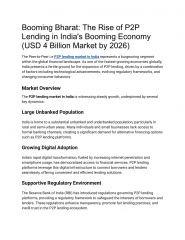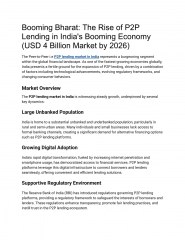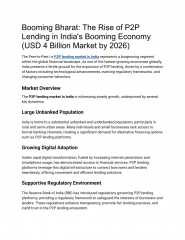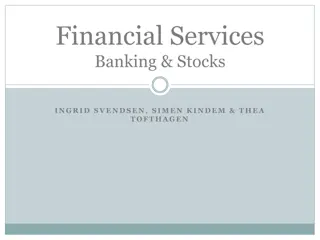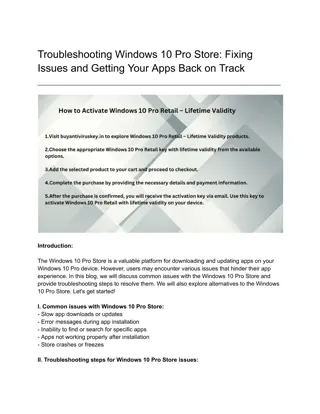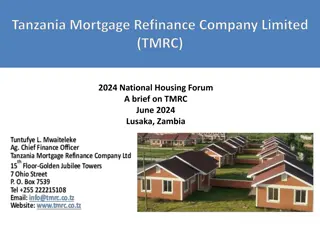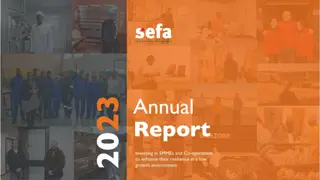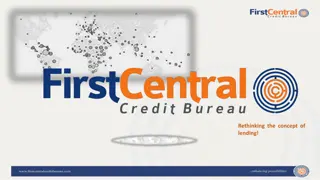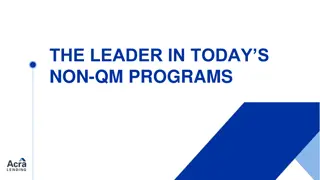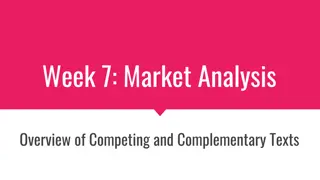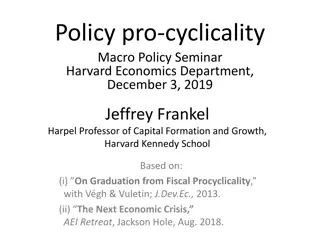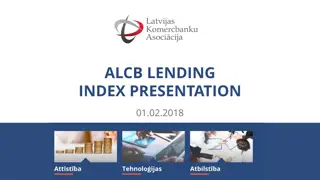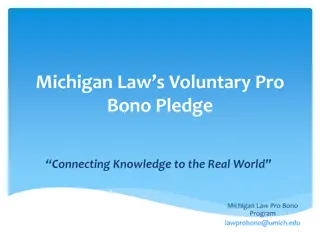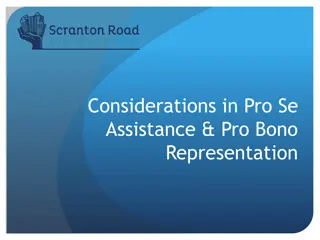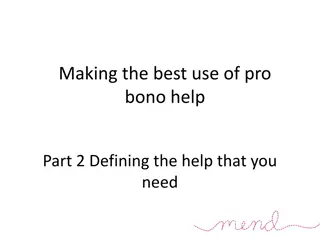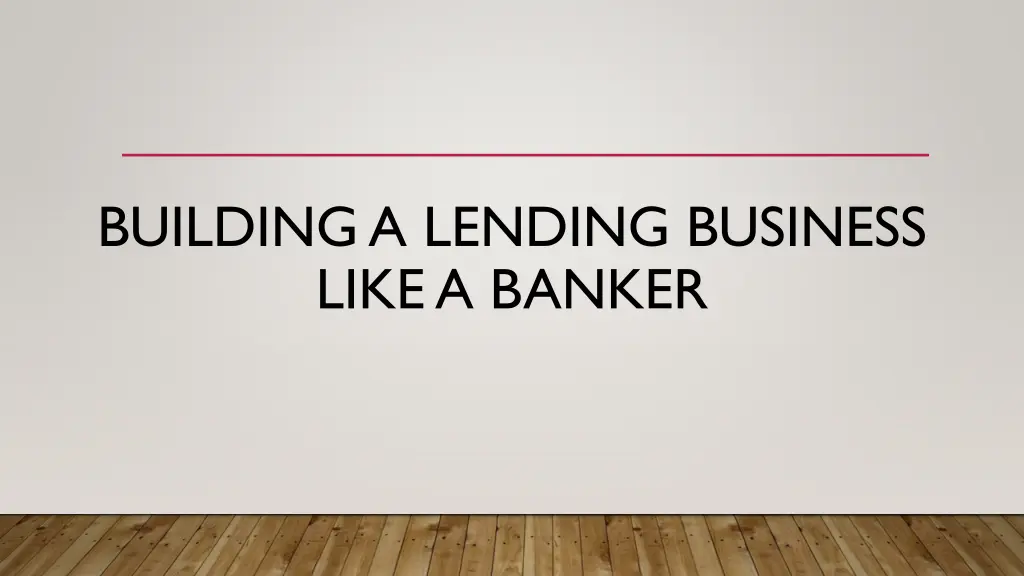
Building a Lending Business Like a Banker
Learn the basics of promissory notes, the difference between unsecured and secured notes, and how to utilize private banking strategies for borrowing money to support your business. Find out why securing loans with assets can provide more financial opportunities.
Download Presentation

Please find below an Image/Link to download the presentation.
The content on the website is provided AS IS for your information and personal use only. It may not be sold, licensed, or shared on other websites without obtaining consent from the author. If you encounter any issues during the download, it is possible that the publisher has removed the file from their server.
You are allowed to download the files provided on this website for personal or commercial use, subject to the condition that they are used lawfully. All files are the property of their respective owners.
The content on the website is provided AS IS for your information and personal use only. It may not be sold, licensed, or shared on other websites without obtaining consent from the author.
E N D
Presentation Transcript
BUILDING A LENDING BUSINESS LIKE A BANKER
PROMISSORY BASICS A promissory note is a legal document that obligates the person who signs it to pay a certain amount of money to another person, and sets forth the terms of payment. The person who owes the money is called the payor, maker, issuer, or promissor. The person who is owed the money is called the payee, promissee, or noteholder. A promissory note is sometimes called a note payable, or simply a note.
UNSECURED VS SECURED An unsecured promissory note can be used to raise capital to start or expand your business. You also can use a promissory note when you borrow money. Alternatively, if you are the holder of a promissory note, you may be able to raise money by selling it. If payment of the promissory note is guaranteed by property, called collateral, it is a secured promissory note. If the payor fails to pay, the noteholder can take the collateral as payment toward the debt. Collateral can be real estate secured by a mortgage, or personal property secured by a security agreement. If no collateral secures payment, the promissory note is called an unsecured promissory note.
SECURED PROMISSORY NOTE (DEMAND) - HOW TO GUIDE PRIVATE BANKING BLUEPRINT MASTERCLASS
PLENTY OF OPPORTUNITY Successful businesses are built on big ideas and long-range goals, but without sufficient capital, many believe that those dreams may never be realized. Limited start-up funds can stop a company in its tracks: business owners often underestimate the amount of money they will need to keep their organization running, and close their doors before they ve had a chance to get a market foothold. Many owners also expect their companies to turn a profit on Day 1, failing to consider expenses, competition, and the time it takes to build a customer base.
YOU CAN STAND IN THE GAP. Whatever the reasons, individuals and companies often turn to borrowing money to keep their businesses afloat. They can turn either to large financial institutions or to friends, colleagues, and relatives for support. Our private banking strategies are extremely useful for those companies looking to borrow money from less formal sources, since commercial lenders may be reluctant to loan money to businesses without defined income streams and, moreover, will usually require businesses to use their standardized forms.
TYING UP THOSE ASSETS Borrowers who agree to sign secured notes may find loans more readily available to them. Lenders know that if a default occurs, they can sell the property used as collateral under the secured note. This protection may, in turn, make a borrower more comfortable with the loan arrangement. Nobody wants to default on a loan or force others to absorb losses on their behalf. With a secured note, you can be sure you re not leaving lenders who may be colleagues or other individuals close to you out in the cold.
. This training will contains everything you ll need to customize and complete your secured promissory note. A written note can minimize confusion, misunderstanding, and error, and clearly set forth the parties expectations and fulfillment obligations. In every way, this promotes a successful and profitable business arrangement.
DOS AND DONTS Before sitting down to sign, decide exactly what your goals are for the note. How much will be borrowed? What interest rates will be applicable? A good agreement is one that captures the intentions of the parties accurately. Take a moment to clarify the terms and conditions of your loan before memorializing them in written form.
DOS AND DONTS Allow each party to spend some time reviewing the promissory note. This will reduce the likelihood, or at least the efficacy, of claims that a party did not understand any terms or know what their obligations were under the document.
DOS AND DONTS Both parties should review the note carefully to ensure that all relevant deal points have been included. Do not assume that certain expectations or terms are agreed to if they are not stated expressly in the document.
DOS AND DONTS The following form is a secured promissory note. This means that the lender takes a secured interest in the borrower s property. If the borrower defaults on the loan, the lender can seize that property almost immediately. By contrast, with an unsecured note, the lender would have to go to court to demand payment if a default occurred.
DOS AND DONTS In general, secured promissory notes are supplemented with and supported by security agreements. Those security agreements are what allow lenders to take property if a default occurs. The enclosed note assumes the existence of a security agreement, but that agreement is not included with this package.
DOS AND DONTS A security interest in property can (and should) be memorialized with a financing statement (more specifically, a document called a UCC financing statement). Once a financing statement is completed and filed with the correct governmental authority, the lender s interest in the property is considered perfected. This means that if future lenders also seek a security interest in the same asset, the lender with the perfected interest would have top priority and could take the property for itself after a default.
DOS AND DONTS The enclosed document is also a demand note. This means that the lender can demand repayment of the loan at any time. This is a point that should be emphasized to the borrower it may be required to pay back that loan on very little notice.
DOS AND DONTS Choose a fair interest rate. Although the enclosed note will rewrite any illegal interest rate to make it legal, it s a good idea to select a more reasonable number. This will decrease the chances of default and make for a less strained relationship between the parties.
DOS AND DONTS The parties should sign only the one original document, and that original should be given to the lender. Make at least one photocopy, make sure that the document says COPY in bold letters, and give the copy to the borrower. After the note has been paid in full, the lender should return the original document to the borrower.
DOS AND DONTS Depending on the nature of its terms, you may decide to have your note witnessed or notarized. This will limit later challenges to the validity of a party s signature.
DOS AND DONTS If your agreement is complicated, do not use the enclosed form. Contact an attorney to help you draft a document that will meet your specific needs.
SECURED PROMISSORY NOTE (DEMAND) INSTRUCTIONS The following provision-by-provision instructions will help you understand the terms of your secured promissory note. The numbers below (e.g., Section 1, Section 2, etc.) correspond to the provisions in the note. Please review the document in its entirety before starting the step-by-step process.
INTRODUCTION. Identifies the document as a note. Write in the date on which the note becomes effective. Identify the parties and, if applicable, what type of organization(s) they are. Note that one party is called the Payee and the other the Borrower. As you may have guessed, the Borrower is the party that is borrowing money and will pay it to the Payee. The Payee may or may not be the same entity as the lender. Under some loan agreements, the lender requires the borrower make payments to a third party.
SECTION 1: PROMISE OF PAYMENT. This is the meat of the note, where the total principal amount and interest rate are stated. This is also where the Payee designates where exactly it should be paid (usually the Payee s business address). The other language ensures that the interest rates set by the parties aren t illegal. In other words, if an agreed-to interest rate is above what the law allows, this section rewrites that provision to make it legal.
SECTION 2: PAYMENT. The parties agreement that the borrowed amount will be repaid immediately, whenever the Payee demands it.
SECTION 3: PREPAYMENT. Explains that the Borrower can pay money to the Payee before it is specifically demanded, and that there is no penalty for doing so.
SECTION 4: SECURITY FOR PAYMENT. Ensures the Borrower s repayment by listing certain property as collateral. Because this note contemplates the simultaneous signing of a security agreement, the details of the collateral arrangement are general. A security agreement should provide more details about the collateral pledged
SECTION 5: EVENTS OF DEFAULT. Lists the occasions on which the Payee can declare that a default has occurred under the loan. The first blank allows the parties to determine the amount of time the Borrower has to make its payment after the demand has been made. If you and the other party want to include additional events of default, you can do that in this section.
SECTION 6: ACCELERATION; REMEDIES ON DEFAULT. A description of the actions the Payee can take if an event of default (as listed in Section 5) occurs.
SECTION 7: WAIVER OF PRESENTMENT; ADDITIONAL DEMAND Indicates that if an event of default occurs, the Payee doesn t have to explain to the Borrower that it is going to take action. The Payee can simply take that action without further notice.
SECTION 8: TIME OF ESSENCE (OPTIONAL). This is an optional provision that is included to allow you and the other party to determine how strictly you want to enforce the time limits in your note. Generally, by including this provision the Payee is allowing the Borrower no leeway if payment isn t within the exact time agreed, the Borrower is in default. By deleting this provision, you are usually allowing the Borrower some reasonable breathing room. If you remove this section, correct the section numbers and references in the note.
SECTION 9: SUCCESSORS AND ASSIGNS. States that the parties rights and obligations will be passed on to heirs or, in the case of companies, to successor organizations.
SECTION 10: NOTICE. Lists the addresses to which all official or legal correspondence should be delivered. Write in a mailing address for both the Borrower and the Payee
SECTION 11: GOVERNING LAW. Allows the parties to choose the state and county laws that will be used to interpret the note. This is not a venue provision: the included language will not impact where a potential claim can be brought. Please write the applicable state and county in the blanks provided.
SECTION 12: ENTIRE AGREEMENT. The parties agreement that the note they re signing is the agreement about the issues involved. Unfortunately, the inclusion of this provision will not prevent a party from arguing that other enforceable promises exist, but it will provide you some protection from these claims.
SECTION 13: NO IMPLIED WAIVER. Explains that even if the Payee ignores or allows the Borrower to break an obligation under the note, it does not mean the Payee waives future rights to require the Borrower to fulfill those obligations.
SECTION 14: COLLECTION COSTS AND ATTORNEY S FEES. Places the responsibility for paying any costs of collecting money under the note on the Borrower s shoulders.
SECTION 15: SEVERABILITY. Protects the terms of the note as a whole, even if one part is later invalidated. A severability clause in a contract states that its terms are independent of one another so that the rest of the contract will remain in force should a court declare one or more of its provisions void or unenforceable.
UNSECURED PROMISSORY NOTES
BORROWING WITH AN UNSECURED PROMISSORY NOTE An unsecured promissory note can be used in connection with borrowing money for your business from a commercial lender, or from friends and family members. If you borrow from a friend or family member, memorializing the loan with an unsecured promissory note gives them some assurance of repayment of the loan, avoids misunderstanding by clearly setting forth the terms for repayment, and gives them proof of the debt in case they later need to file a claim against your estate. There are various ways to structure repayment. Especially for a relatively small loan, you might use a note that is to be paid back in full, with one payment, in a short period of time. Such an unsecured promissory note lump sum payment can be with or without interest. Either a long- term or a short term-promissory note also can be repaid in periodic installments, typically with monthly payments.
SELLING AN UNSECURED PROMISSORY NOTE If you are the holder of a promissory note, you may be able to sell the note for cash. However, you will be selling the note for less than the face value. Generally, a note buyer will discount the note by 10 to 35 percent. For example, if the amount due under the promissory note is $10,000, and the buyer discounts the note 25 percent, you will receive $7,500. The discount may vary from buyer to buyer, and will take into consideration such factors as the note's being unsecured, the amount of the note, the interest rate of the note, and especially the credit rating of the note's promissor. Selling an unsecured promissory note will result in a greater discount than if it were a secured note. It will also be more difficult to find a buyer for an unsecured note. Debt collection agencies often buy notes that are not in default, as well as those in default.
HOW TO COLLECT ON AN UNSECURED PROMISSORY NOTE If the borrower fails to pay as required by the terms of the promissory note, the first step is to send the borrower a letter giving notice of the default, giving a deadline for payment, and giving notice that further collection efforts will be pursued if payment is not made. If the default continues, the noteholder has two options: Obtain the services of a debt collector, or file suit against the borrower. The federal Fair Debt Collection Practices Act is a complex set of laws governing debt collection, and has significant penalties for violations. Therefore, using the services of a knowledgeable attorney or debt collection agency are recommended.
DEBT COLLECTION AGENCIES Some debt collection agencies will buy the note that is in default for a discount. This will be a much greater discount than if the note were not in default. The agency then keeps whatever it ends up collecting from the borrower. Other agencies will keep a percentage of what they collect, and forward the balance to you.
FILING A LAWSUIT Collecting on an unsecured promissory note through the courts is a two-step process. First, you need to go through the court process to obtain a judgment against the borrower. Then you need to try to attach the borrower's wages, bank accounts, or other assets in order actually get paid. If the borrower does not have sufficient assets that can be attached to satisfy the debt, you are out of luck. And, if the borrower files for bankruptcy, that can at best delay the process, and at worst eliminate your ability to collect what you are owed. If you use an unsecured promissory note to borrow from a commercial lender, the lender will provide the forms it requires. If you borrow from a friend or family member, you will need to create the note

